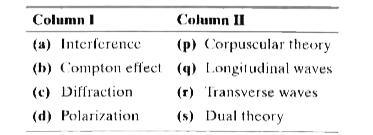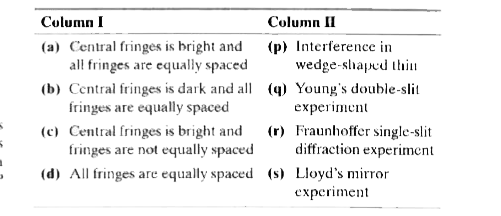When waves from two herent sources, having amplitudes a and b superimpose, the amplitude R of the resultant wave is given by R=√a2+b2+2abcosϕ where ϕ is the constant phase angle between the two waves. The resultant intensity I is directly proportional to the square of the amplitude of the resultant wave, i.e., I∝R2,
i.e., I∝(a2+b2+2abcosϕ)
For constructive interference, ϕ=2nπ,
Imax=(a+b)2
For destructive interference, ϕ=(2n−1)π
Imin=(a−b)2
If I1,I2 are intensities of light from two slits of widths ω1 and ω2, then I1I2=ω1ω2=a2b2
Light waves from two coherent sources of intensity ratio 81:1 produce interference. With the help of the passsage given above, choose the most appropriate alternative for each of the following questions :
The ratio of amplitude of two sources is
1 : 4
4 : 1
2 : 1
1 : 2..
The correct Answer is:D
Step by step video, text & image solution for When waves from two herent sources, having amplitudes a and b superimpose, the amplitude R of the resultant wave is given by R = sqrt(a^(2) + b^(2) + 2ab cos phi) where phi is the constant phase angle between the two waves. The resultant intensity I is directly proportional to the square of the amplitude of the resultant wave, i.e., I prop R^(2), i.e., I prop (a^(2) + b^(2) + 2 ab cos phi) For constructive interference, phi = 2 n pi, I_(max) = (a + b)^(2) For destructive interference, phi = (2 n - 1)pi I_(min) = (a - b)^(2) If I_(1), I_(2) are intensities of light from two slits of widths omega_(1) and omega_(2), then (I_(1))/(I_(2)) = (omega_(1))/(omega_(2)) = (a^(2))/(b^(2)) Light waves from two coherent sources of intensity ratio 81 : 1 produce interference. With the help of the passsage given above, choose the most appropriate alternative for each of the following questions : The ratio of amplitude of two sources is by Physics experts to help you in doubts & scoring excellent marks in Class 12 exams.
Topper's Solved these Questions
- BOOK - RESNICK AND HALLIDAYCHAPTER - INTERFERENCE AND DIFFRACTION EXERCISE - PRACTICE QUESTIONS (Matrix-Match)1videos
INTERFERENCE AND DIFFRACTION
- BOOK - RESNICK AND HALLIDAYCHAPTER - INTERFERENCE AND DIFFRACTION EXERCISE - PRACTICE QUESTIONS7videos
INTERFERENCE AND DIFFRACTION
- BOOK - RESNICK AND HALLIDAYCHAPTER - INTERFERENCE AND DIFFRACTION EXERCISE - PRACTICE QUESTIONS (More than One Correct Choice Type)23videos
INTERFERENCE AND DIFFRACTION
- BOOK - RESNICK AND HALLIDAYCHAPTER - HYDROGEN ATOMEXERCISE - PRACTICE QUESTIONS(Integer Type)6videos
HYDROGEN ATOM
- BOOK - RESNICK AND HALLIDAYCHAPTER - MAGNETIC FIELDS DUE TO CURRENTSEXERCISE - Practice Question (Integer Type)4videos
MAGNETIC FIELDS DUE TO CURRENTS
Similar Questions
Match the statements in Column I labeled as (a), (b), (c), and (d) with those in Column II labeled as (p), (q). (c), and (s). Any given statement in Column I can have correct matching with one or more statements in Column II.
Match the property with the concept it is based on.
 01:03View Solution
01:03View SolutionMatch the statements in Column I labeled as (a), (b), (c), and (d) with those in Column II labeled as (p), (q). (c), and (s). Any given statement in Column I can have correct matching with one or more statements in Column II.
Match the observation given in Column I with the experiments given in Column II.
 01:16View Solution
01:16View SolutionIf white light is used in a Young's double-slit experiment, the
02:13View SolutionThe radius of hydrogen atom in its ground state is 5.3×10−11m. After collision with an electron, it is found to have a radius of 21.2×10−11m. What is the principal quantum number of the final state of the atom?
07:01View SolutionA steady current I goes through a wire loop PQR having shape of a right angle triangle with PQ=3x,PR=4xandQR=5x. If the magnitude of the magnetic field at P due to this loop is k(μ0I48πx), find the value of K.
03:10View SolutionWhen waves from two herent sources, having amplitudes a and b superimpose, the amplitude R of the resultant wave is given by R = sqrt(a^(2) + b^(2) + 2ab cos phi) where phi is the constant phase angle between the two waves. The resultant intensity I is directly proportional to the square of the amplitude of the resultant wave, i.e., I prop R^(2) , i.e., I prop (a^(2) + b^(2) + 2 ab cos phi) For constructive interference, phi = 2 n pi , I_(max) = (a + b)^(2) For destructive interference, phi = (2 n - 1)pi I_(min) = (a - b)^(2) If I_(1), I_(2) are intensities of light from two slits of widths omega_(1) and omega_(2) , then (I_(1))/(I_(2)) = (omega_(1))/(omega_(2)) = (a^(2))/(b^(2)) Light waves from two coherent sources of intensity ratio 81 : 1 produce interference. With the help of the passsage given above, choose the most appropriate alternative for each of the following questions : The ratio of amplitude of two sources is
02:33View SolutionWhen waves from two herent sources, having amplitudes a and b superimpose, the amplitude R of the resultant wave is given by R=√a2+b2+2abcosϕ where ϕ is the constant phase angle between the two waves. The resultant intensity I is directly proportional to the square of the amplitude of the resultant wave, i.e., I∝R2,
i.e., I∝(a2+b2+2abcosϕ)
For constructive interference, ϕ=2nπ,
Imax=(a+b)2
For destructive interference, ϕ=(2n−1)π
Imin=(a−b)2
If I1,I2 are intensities of light from two slits of widths ω1 and ω2, then I1I2=ω1ω2=a2b2
Light waves from two coherent sources of intensity ratio 81:1 produce interference. With the help of the passsage given above, choose the most appropriate alternative for each of the following questions :
The ratio of slit widths of the two sources is04:14View SolutionWhen waves from two herent sources, having amplitudes a and b superimpose, the amplitude R of the resultant wave is given by R=√a2+b2+2abcosϕ where ϕ is the constant phase angle between the two waves. The resultant intensity I is directly proportional to the square of the amplitude of the resultant wave, i.e., I∝R2,
i.e., I∝(a2+b2+2abcosϕ)
For constructive interference, ϕ=2nπ,
Imax=(a+b)2
For destructive interference, ϕ=(2n−1)π
Imin=(a−b)2
If I1,I2 are intensities of light from two slits of widths ω1 and ω2, then I1I2=ω1ω2=a2b2
Light waves from two coherent sources of intensity ratio 81:1 produce interference. With the help of the passsage given above, choose the most appropriate alternative for each of the following questions :
The ratio of maxima and minima in the interference pattern is02:48View SolutionAssertion (A) : If two waves of same amplitude produce a resultant wave of same amplitude produce a resultant wave of same of same amplitude, then the phase difference between them may br 120^(@) . Reason (R ) : The resultant amplitude of two waves is equal to algebraic sum of amplitude of two waves.
05:01View SolutionThe resultant amplitude, when two waves of two waves of same frequency but with amplitudes a_(1) and a_(2) superimpose at phase difference of pi//2 will be :-
04:07View SolutionTwo waves of equal amplitude when superposed, give a resultant wave having an amplitude equal to that of either wave. The phase difference between the two waves is
05:44View SolutionWhen waves from two coherent source of amplitudes a and b superimpose , the amplitude R of the resultant wave is given by R = sqrt(a^(2)+b^(2)+2ab cos phi). where phi is the constant phase angle between the two waves. The resultant intensity I is directly proportional to the square of the amplitude of the resultant wave i.e I prop R^(2) i.e, I prop (a^(2) +b^(2) +2ab cos phi ) For constructive interference , phi = 2n pi " ""and"" " I _("max") = (a+b)^(2) For destructive interference , phi = (2n-1) pi "and" I_("min") = (a-b)^(2) If I_(1) I_(2) are intensities from two slits of width w_(1) "and" w_(2) then I_(1)/I_(2)=w_(1)/w_(2)=a^(2)/b^(2) Light waves from two coherent sources of intensity ratio 81 : 1 produce interference. With the help of the passage choose the most appropriate alternative for each of the following questions The ratio of amplitudes of two sources is
02:53View SolutionWhen waves from two coherent source of amplitudes a and b superimpose , the amplitude R of the resultant wave is given by R = √a2+b2+2abcosϕ.
where ϕ is the constant phase angle between the two waves. The resultant intensity I is directly proportional to the square of the amplitude of the resultant wave i.e I∝R2 i.e,
I∝(a2+b2+2abcosϕ)
For constructive interference ,
ϕ=2nπ and Imax=(a+b)2
For destructive interference ,
ϕ=(2n−1)πandImin=(a−b)2
If I1I2 are intensities from two slits of width w1andw2 then
I1I2=w1w2=a2b2
Light waves from two coherent sources of intensity ratio 81 : 1 produce interference. With the help of the passage choose the most appropriate alternative for each of the following questions
The ratio of slit widths of the two sources is03:33View SolutionWhen waves from two coherent source of amplitudes a and b superimpose , the amplitude R of the resultant wave is given by R = √a2+b2+2abcosϕ.
where ϕ is the constant phase angle between the two waves. The resultant intensity I is directly proportional to the square of the amplitude of the resultant wave i.e I∝R2 i.e,
I∝(a2+b2+2abcosϕ)
For constructive interference ,
ϕ=2nπ and Imax=(a+b)2
For destructive interference ,
ϕ=(2n−1)πandImin=(a−b)2
If I1I2 are intensities from two slits of width w1andw2 then
I1I2=w1w2=a2b2
Light waves from two coherent sources of intensity ratio 81 : 1 produce interference. With the help of the passage choose the most appropriate alternative for each of the following questions
The ratio of maxima and minima in the interference pattern is04:05View SolutionWhen waves from two coherent source of amplitudes a and b superimpose , the amplitude R of the resultant wave is given by R = √a2+b2+2abcosϕ.
where ϕ is the constant phase angle between the two waves. The resultant intensity I is directly proportional to the square of the amplitude of the resultant wave i.e I∝R2 i.e,
I∝(a2+b2+2abcosϕ)
For constructive interference ,
ϕ=2nπ and Imax=(a+b)2
For destructive interference ,
ϕ=(2n−1)πandImin=(a−b)2
If I1I2 are intensities from two slits of width w1andw2 then
I1I2=w1w2=a2b2
Light waves from two coherent sources of intensity ratio 81 : 1 produce interference. With the help of the passage choose the most appropriate alternative for each of the following questions
If two slits in Young's experiment have width ratio 1:4 the ratio of maximum and minimum intensity in the interference pattern would be01:44View SolutionDerive the expression for the resultant displacement and amplitude when two waves having the same amplitude and a phase difference of phi superpose.
02:00View Solution

